Manitoba represents the most eastern of the 3 Prairie Provinces. It has borders with Saskatchewan on the west, North Dakota and Minnesota on the south, and Ontario on the east. To the north, it is limited by Nunavut and Hudson Bay.
Manitoba has a diverse bird population, reflecting the state’s diverse habitats and seasonal fluctuations in available resources.
Manitoba is home to approximately 145 bird species, including over 88% of them migrating yearly.
Across Manitoba, there are numerous common birds that might also come to your yard or feeders. These are the birds that occur the most often in state checklists provided to ebird by bird watchers.
This page provides identity information and photographs to assist you in identifying and attracting more of the typical backyard birds found across Manitoba.
| Image | Name |
|---|---|
 | Black-capped Chickadee |
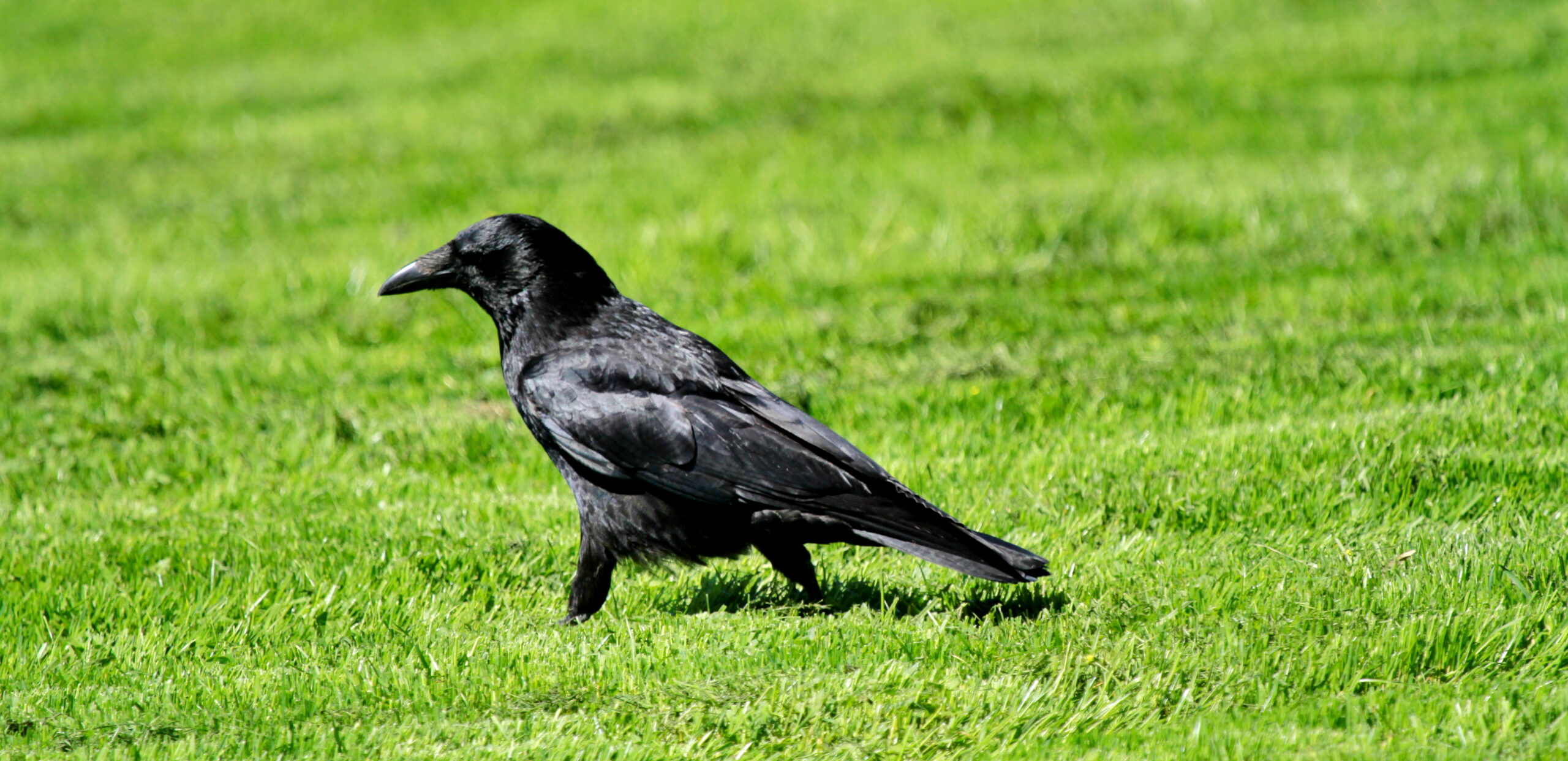 | American Crow |
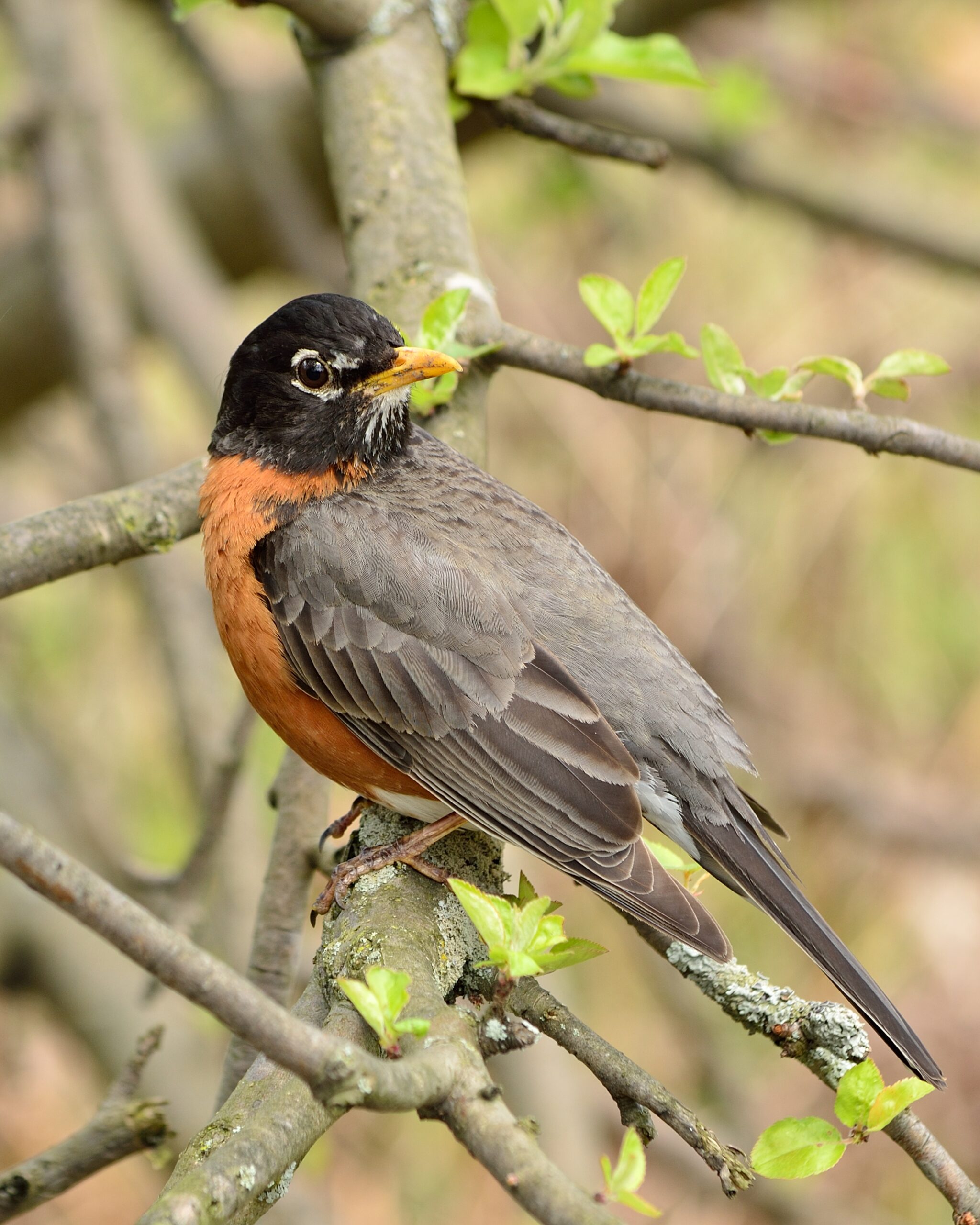 | American Robin |
 | Blue Jay |
 | White-breasted Nuthatch |
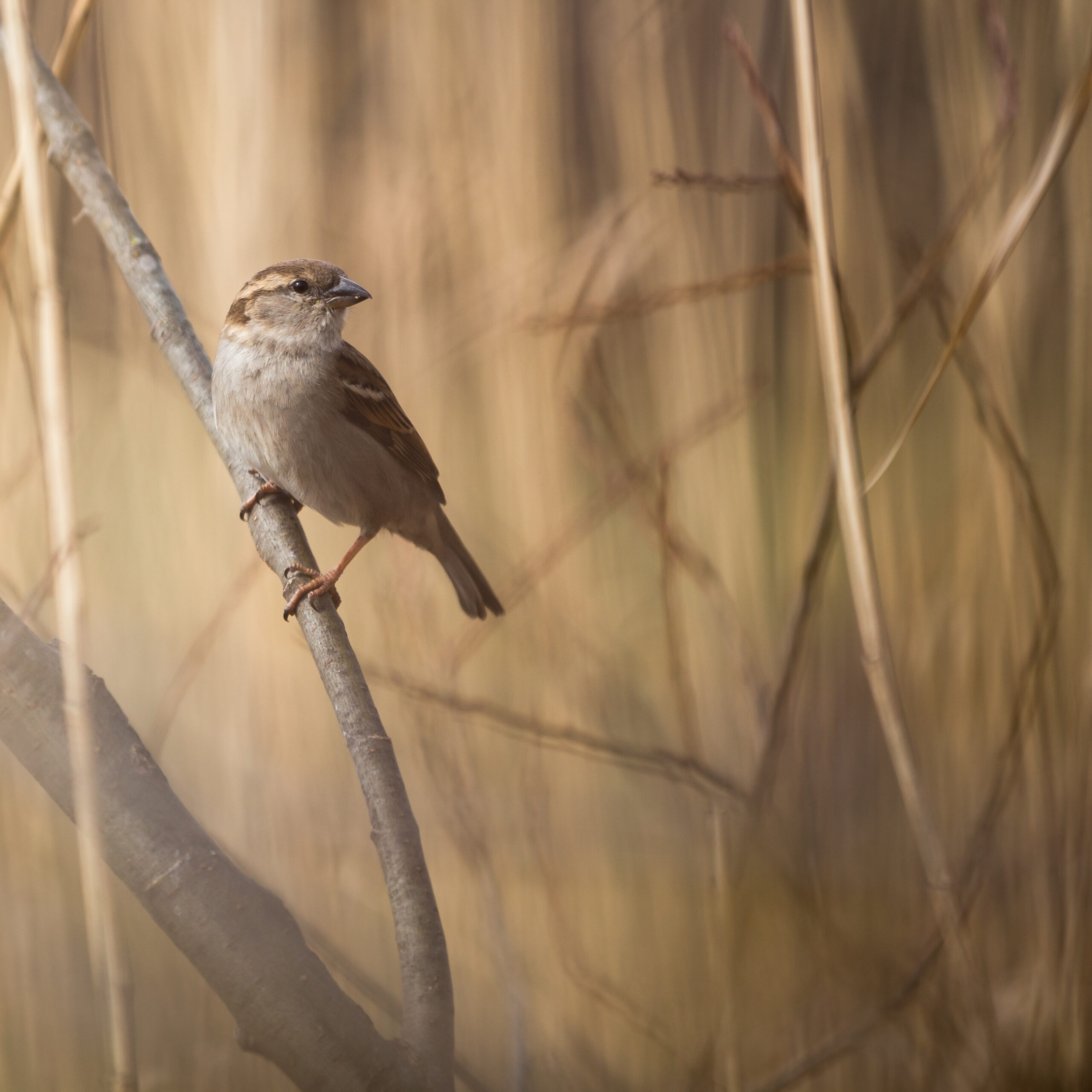 | House Sparrow |
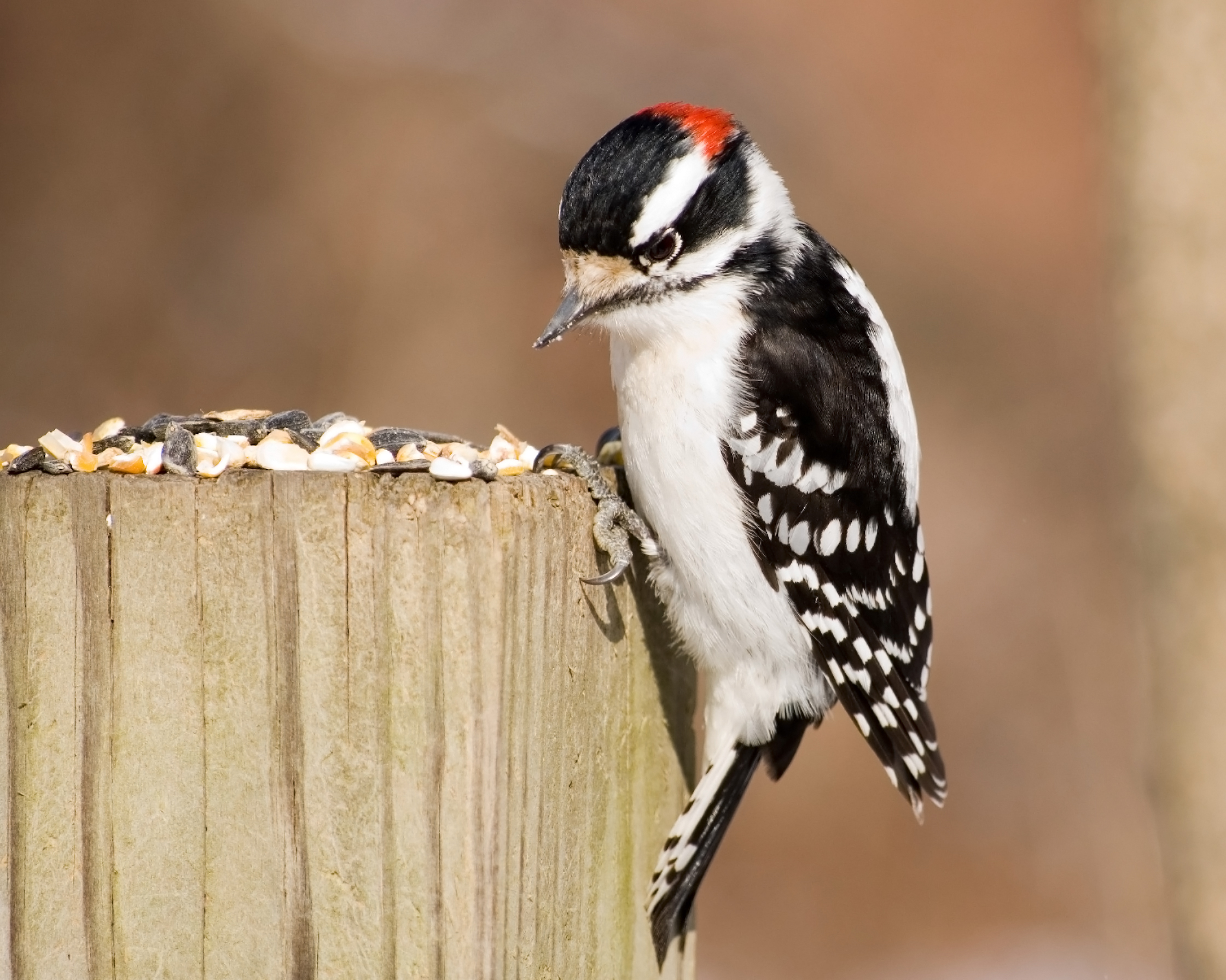 | Downy Woodpecker |
 | Red-winged Blackbird |
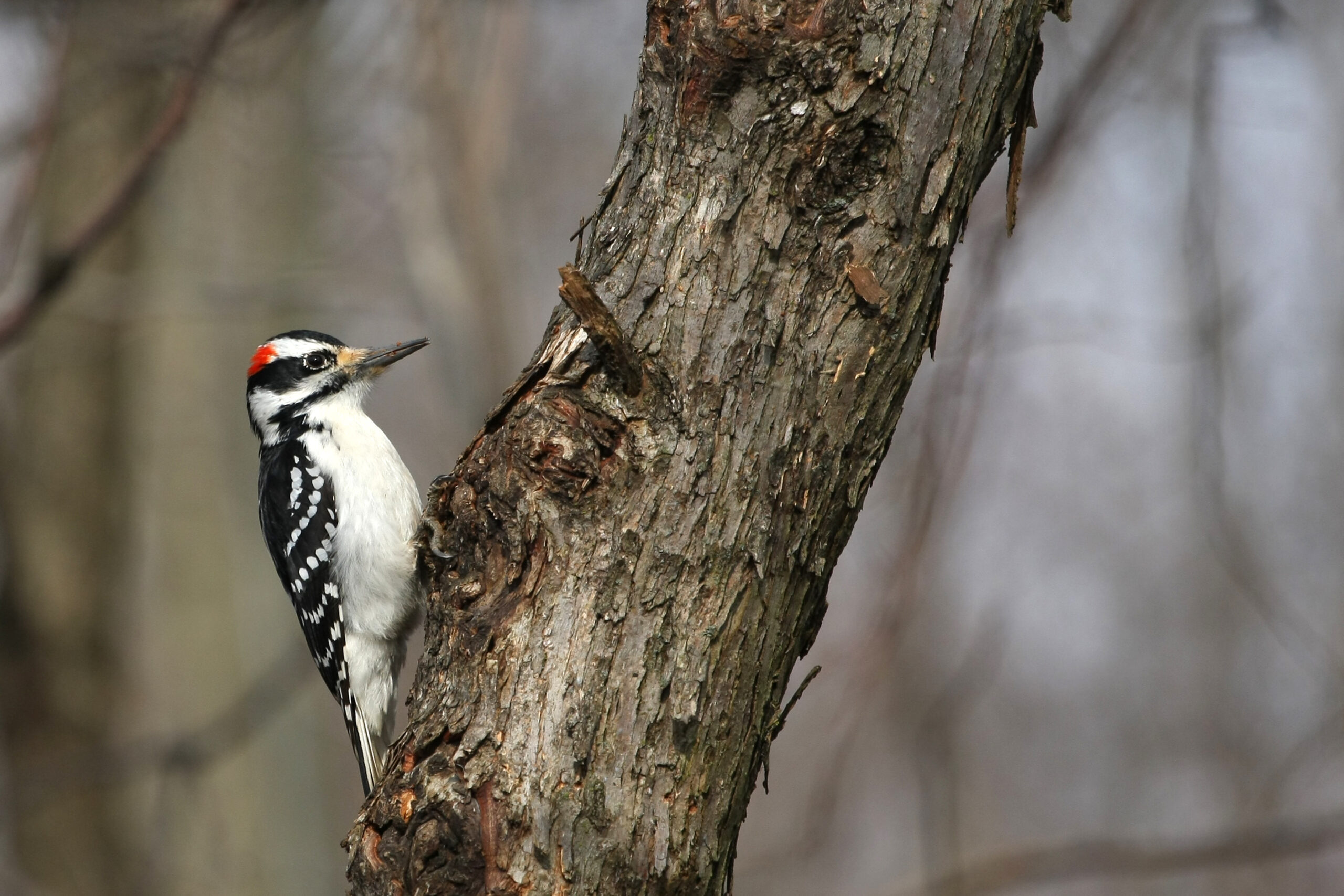 | Hairy Woodpecker |
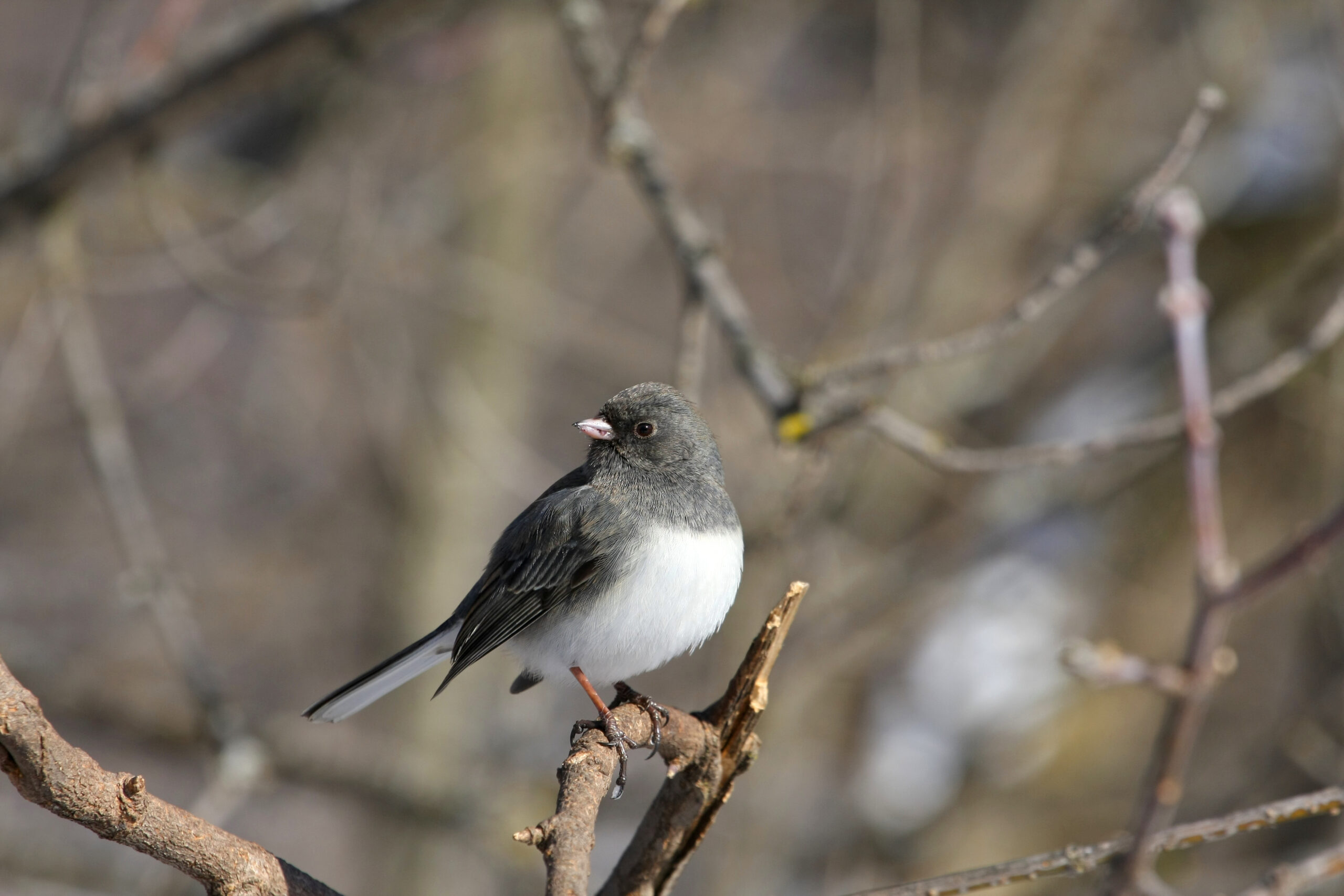 | Dark-eyed Junco |
 | White-throated Sparrow |
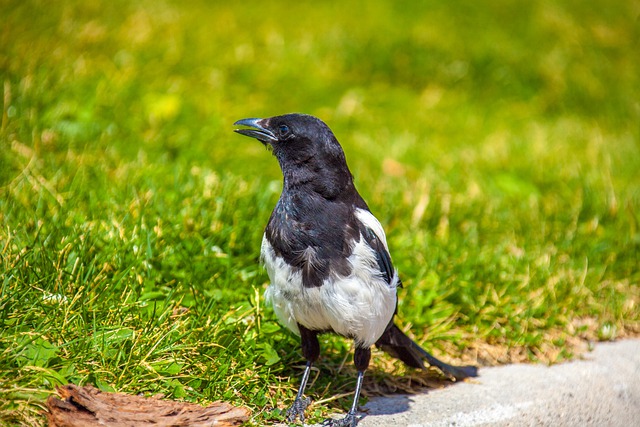 | Black-billed Magpie |
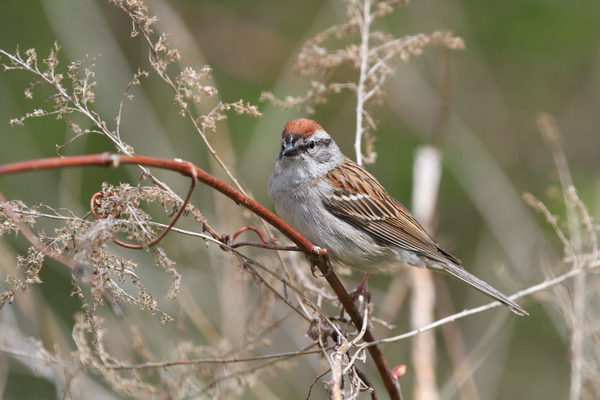 | Chipping Sparrow |
 | American Goldfinch |
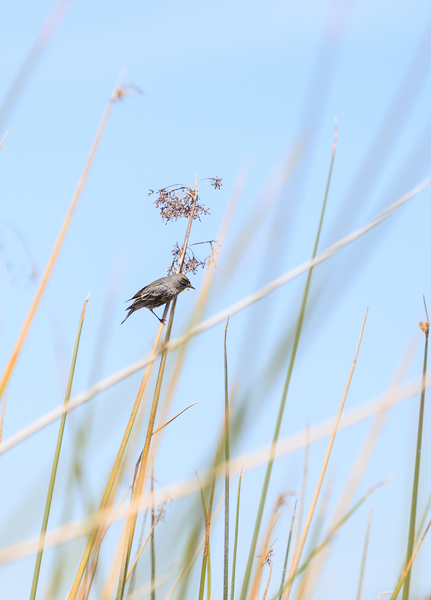 | Yellow-rumped Warbler |
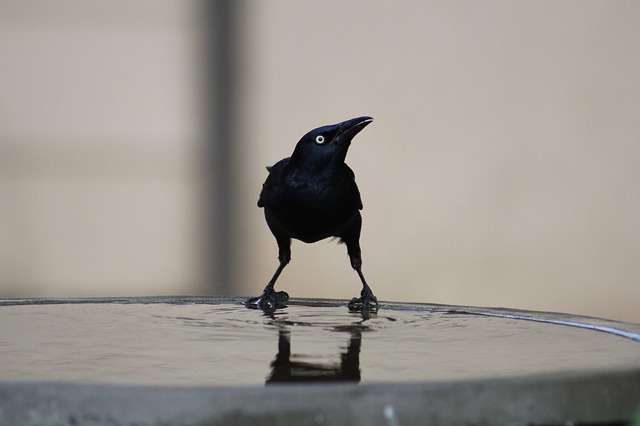 | Common Grackle |
Most Common Birds in Manitoba
1. Black-capped Chickadee
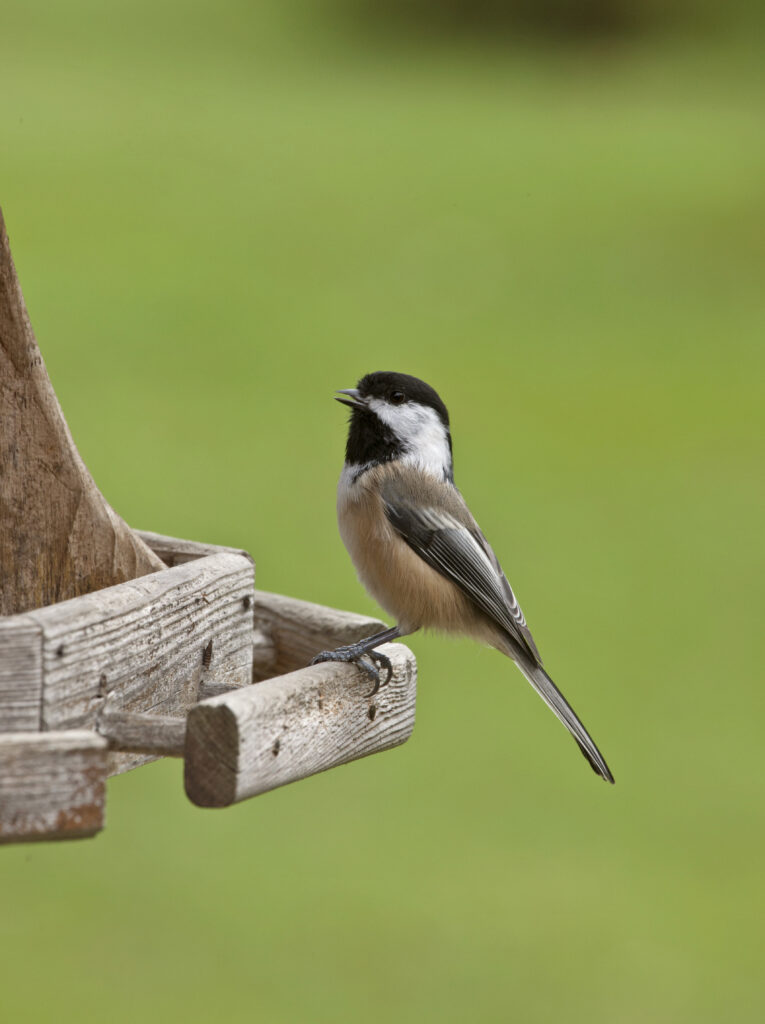
Black-capped Chickadees live in Manitoba all year. Despite the fact that they appear on more checklists during the winter, this is owing to the scarcity of other birds throughout the winter, and they approach feeders more often.
They don’t really migrate and appear on 26% of summer and 62% of winter checklists reported to the department by bird watchers.
The Black-capped Chickadee is a beautiful bird having a little body and a large round head. These birds will cheerfully eat from garden feeders and inspect everyone and everything, even you!
They possess white faces, blackheads and beaks, and grey wings, backs, and tails.
Black-capped Chickadees don’t really move and may be seen across the northern part of the United States and Canada.
Habitat & Food
They may be found in forests, parkland, and open woodlands. The Black-capped Chickadee feeds on berries, suet, seeds, spiders, and insects.
Peanuts, peanut butter, suet, and Sunflower seeds can bring Black-capped Chickadees to your garden. They will even eat from your palm and are frequently the first species to notice new feeders. They will also utilize nest boxes, particularly if they are filled with wood shavings.
| Scientific Name | Poecile atricapillus |
| Weight | 9.1 to 14 grams (0.3 to 0.5 ounces) |
| Length | 11 to 14 centimeters (4.5 to 5.8 inches) |
| Wingspan | 16 to 21 centimeters (6.2 to 8.4 inches) |
2. American Crow

The mating season for American Crows is in Manitoba; however, their numbers grow throughout the migration. They occur on 37% of summer and up to 54% of migratory checklists.
Crows in the United States are huge, all-black birds that emit a harsh, cawing noise.
The majority of the lower 48 states, as well as the Pacific coasts of Alaska and Canada, have American Crows throughout the year. Those that nest across Canada and the northern Midwest spend the winter mostly in the south.
Habitat & Food
They are widespread birds that may be encountered in a variety of settings, including woodlands, trees, cities, fields, and beaches.
They eat almost anything and prefer to forage on the ground, where they consume fruit, seeds, insects, and earthworms. They also consume fish, clams, juvenile turtles, and mussels, as well as the eggs and nestlings of many bird species.
During the winter, approximately two million American Crows congregate to sleep in raucous communal roosts.
| Scientific Name | Corvus brachyrhynchos |
| Weight | 315 to 620 grams (11.1 to 21.8 ounces) |
| Length | 41 to 53 centimeters (15.7 to 20.8 inches) |
| Wingspan | 86 to 100 centimeters (33.4 to 39.6 inches) |
3. American Robin

American Robins spend the mating season across Manitoba, where they may be seen on 47% of summertime checklists. They are mostly seen from April through October; however, some are around all year and appear on 1% of wintertime checklists.
American Robins are frequent in gardens, where they consume earthworms. Their chests are orange or crimson, while their heads and backs are black. Because they prefer to roost in trees in the winter, you can easily see them in the garden in the early spring.
American Robins live across the lower 48 states, as well as along the coasts of Western Canada and Alaska. Those that nest in Canada and Alaska’s interior migrate south for the winter.
Habitat & Food
American Robins might be present in a variety of environments, such as woods, mountains, and forests, as well as in lawns, fields, and parkland. Insects, earthworms, fruit, and snails are among the foods they like.
Sunflower seeds, suet and fruit, peanut hearts, and mealworms will all draw American Robins toward your garden. Plant several natural berry-producing plants, such as sumac, hawthorn, juniper, and dogwood.
| Scientific Name | Turdus migratorius |
| Weight | 76 to 85 grams (2.76 to 3.0 ounces) |
| Length | 21 to 28 centimeters (7.8 to 11.1 inches) |
| Wingspan | 32 to 40 centimeters (12.1 to 15.8 inches) |
4. Blue Jay

Blue Jays are most often seen in Manitoba during the wintertime; however, they may be seen throughout the year. They appear on 18% of summer and 33% of winter season checklists.
Blue Jays are huge songbirds with an erect blue crest, blue and black upper back, and white lower parts that are frequent.
Blue Jays spend the entire year across southern Canada and the eastern United States. Several birds will travel west during the winter, although not very often.
Habitat & Food
They are loud birds that move in family groupings and consume acorns when they become available. They live in woodlands, primarily around oak trees, since they consume acorns.
They’re also common in gardens around bird feeders. In addition to acorns, they eat nuts, insects, seeds, and grain. They might even remove eggs or hatchlings from nests.
Blue Jays are huge birds that love to come in, pick up a peanut or sunflower seed, then fly away to feast. They like platform or plate feeders that allow them to depart quickly.
They enjoy peanuts, sunflower seeds, and suet from open-tray feeders or post-mounted hopper feeders. They might also like a birdbath.
| Scientific Name | Cyanocitta cristata |
| Weight | 24 to 30 centimeters (9.7 to 11.7 inches) |
| Length | 71 to 100 grams (2.4 to 3.5 ounces) |
| Wingspan | 33 to 43 centimeters (13.5 to 16.9 inches) |
5. White-breasted Nuthatch

Despite the fact that White-breasted Nuthatches are often more common within winter checklists across Manitoba, they are year-round inhabitants, appearing in 14% of summer and 38% of winter checklists.
White-breasted Nuthatches are energetic tiny birds having gray-blue backs and white faces and bellies, as well as a black crown. They frequently have chestnut coloration on the lower abdomen and beneath the tail.
White-breasted Nuthatches may be seen throughout the entire United States and southern Canada.
Habitat & Food
White-breasted Nuthatches may be found among deciduous woods, woodland borders, parkland, and gardens with trees or feeders. They mostly consume insects, including beetles and their caterpillars, larvae, spiders, and ants.
White-breasted Nuthatches consume seeds and nuts such as acorns, hawthorns, sunflower seeds, and occasionally maize crops. They stuff huge nuts and acorns into the bark of trees and then smash them with their bills to break or ‘hatch’ them, allowing the seed to escape.
| Scientific Name | Sitta carolinensis |
| Weight | 12 to 14 centimeters (5.2 to 5.5 inches) |
| Length | 17 to 30 grams (0.7 to 1.1 ounces) |
| Wingspan | 21 to 27 centimeters (7.8 to 10.6 inches) |
6. House Sparrow
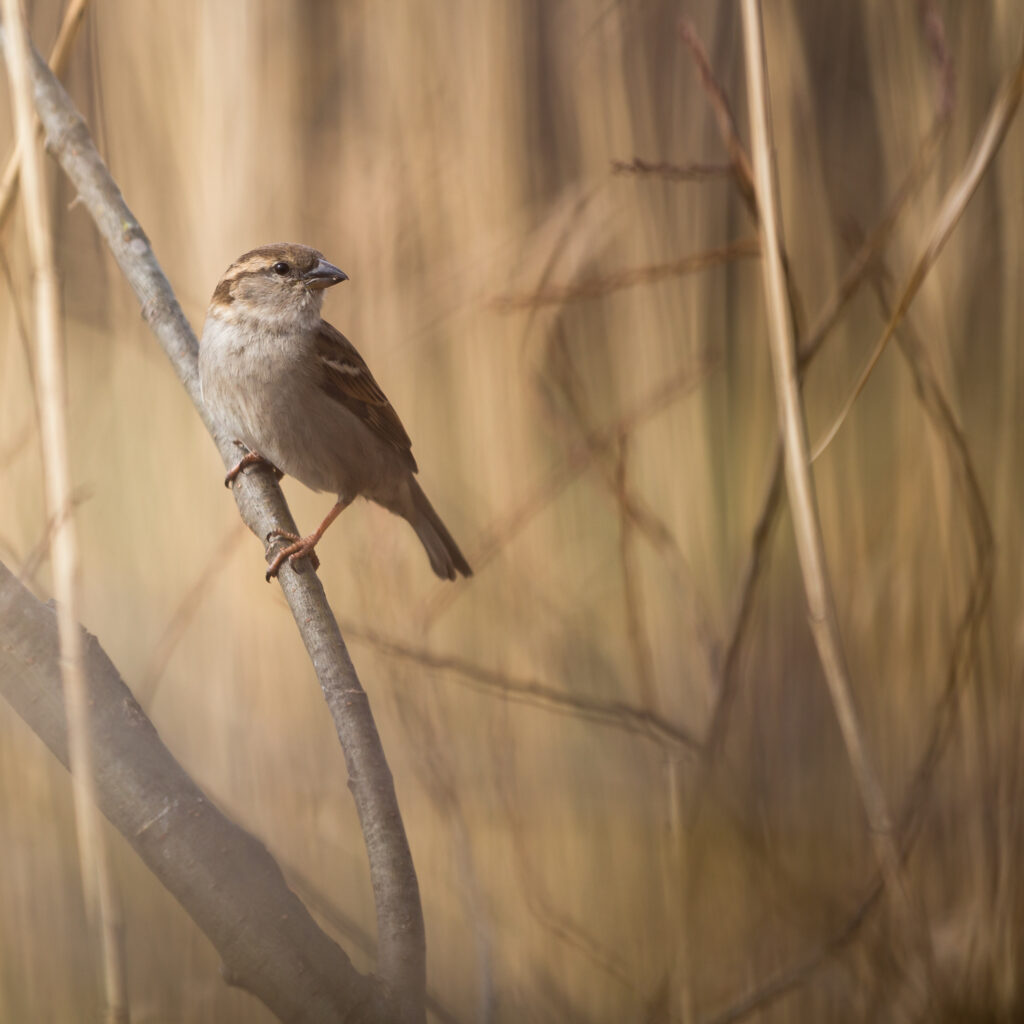
House Sparrows are an invasive species that may be seen in Manitoba throughout the year. They don’t really migrate and appear on 20% of summer and 30% of wintertime checklists supplied by provincial bird watchers.
Another imported species that has thrived and has become one of the most frequent birds is the House Sparrow. Their heads are grey and brown, with white cheeks. Their backs appear black and brown, with grey tummies.
House Sparrows spend the whole year throughout the United States and southern Canada.
They might well be found around buildings and homes, and they might be rather friendly, even eating out of your palm.
House Sparrows mostly feed on seed and grain, along with wasted food. They are a problem since they are non-native, although they may be spotted in gardens if they are not fed.
Most types of birdseed, such as sunflower seeds, millet, and maize, can draw House Sparrows toward your garden feeders.
| Scientific Name | Passer domesticus |
| Weight | 26 to 30 grams (0.8 to 1.1 ounces) |
| Length | 14 to 17 centimeters (5.8 to 6.7 inches) |
| Wingspan | 18 to 25 centimeters (7.4 to 9.8 inches) |
7. Downy Woodpecker

Downy Woodpeckers may be seen in Manitoba throughout the year; however, they are more common in the winter. They feature 12% of summer and 32% of winter season checklists.
Downy Woodpeckers are small species of birds that attract garden feeders. They are frequently mixed with other birds, like chickadees and nuthatches.
They are white and black, having a red spot on the head back. They resemble Hairy Woodpeckers but are tiny.
Downy Woodpeckers need not travel and may be found in all provinces and states with the exception of northern Canada.
Habitat & Food
Downy woodpeckers may be found among woodlots, along city parks, streams, and backyards, and they mostly consume beetle larvae and insects but occasionally grains, berries, and acorns.
Downy Woodpeckers might visit the garden to eat suet, but they will also consume peanuts, millet, and black oil sunflower seeds from platform feeders.
| Scientific Name | Dryobates pubescens |
| Weight | 22 to 28 grams (0.6 to 1.0 ounces) |
| Length | 15 to 17 centimeters (5.4 to 6.7 inches) |
| Wingspan | 25-30 centimeters (9.8 – 11.8 inches) |
8. Red-winged Blackbird
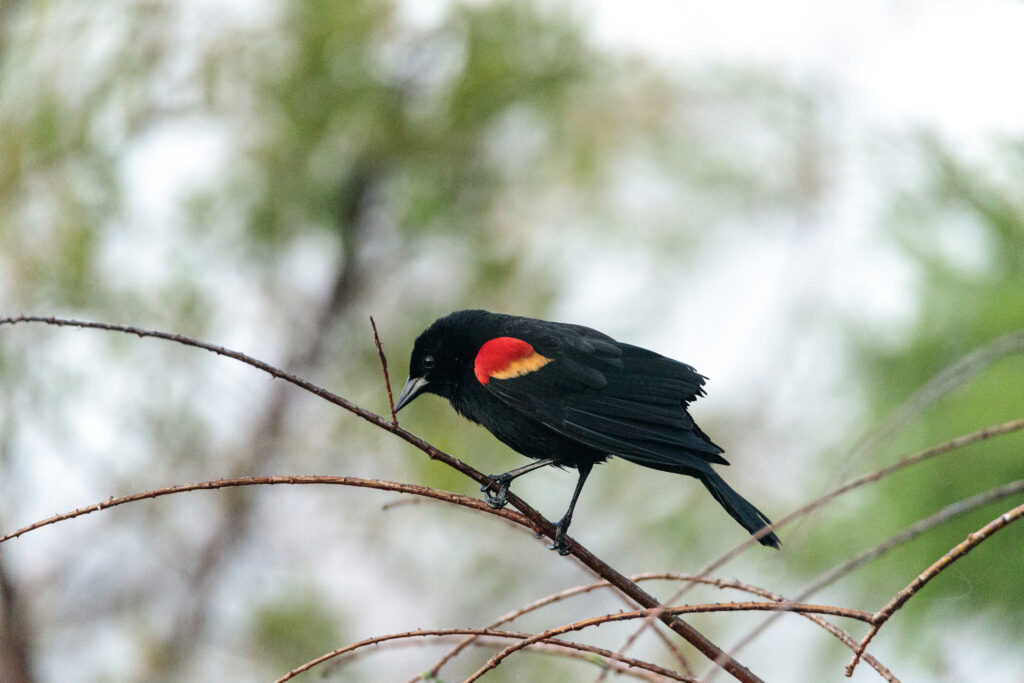
During the mating season, red-winged blackbirds are regularly seen in Manitoba and featured on 39% of summer checklists reported by bird observers. Whereas many individuals go south for the winter, a small number stay in the province throughout the year.
Red-winged blackbirds are quite numerous and simple to distinguish since they are entirely black apart from the reddish-orange wing spots. Females are drab compared to the streaky brown color.
Red-winged Blackbirds may be seen throughout the entire lower 48 and on British Columbia’s Pacific Coast. Those that nest across Canada and certain northern states of the United States travel south during the winter.
They usually sit on power lines, and the males will fiercely guard their territory during mating season, even hitting anybody who ventures too close to their nests. During the wintertime, they roost by the thousands.
By sprinkling both grain and seeds on the ground, you may attract Red-winged Blackbirds visiting your yard. They will also consume food from large tubes or station feeders.
| Scientific Name | Agelaius phoeniceus |
| Weight | 1.2 to 2.7 ounces (31 to 77 grams) |
| Length | 6.6 to 9.1 inches (16 to 23 centimeters) |
| Wingspan | 12.1 to 15.8 inches (30 to 40 centimeters) |
9. Hairy Woodpecker
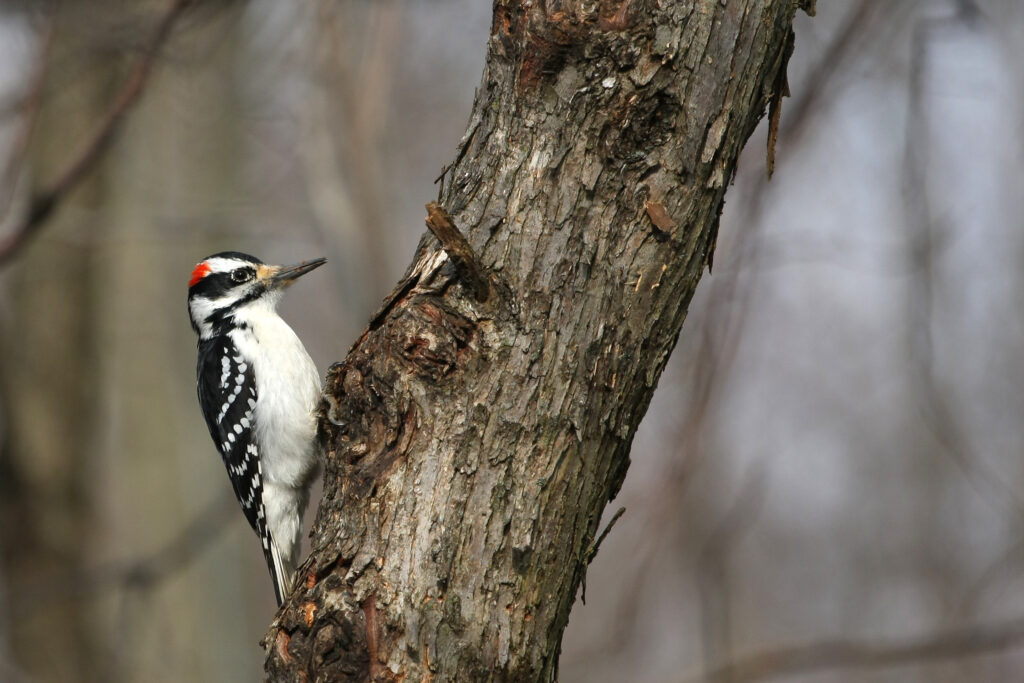
Hairy Woodpeckers are most often seen in Manitoba from September through mid-March, although they may be seen all year and don’t migrate. They appear across 12% of the province’s summer and 31% of its wintertime checklists.
A hairy Woodpecker is a medium-sized woodpecker with a white and black design on their backs and a huge white spot. The males have quite a red flash on the rear of their forehead.
They resemble Downy Woodpeckers in appearance but also are bigger and have longer bills. They are difficult to identify because they dwell in the same regions.
Except for the extreme north of Canada, Hairy Woodpeckers don’t really migrate and may be found in all 50 states and Canada.
Hairy Woodpeckers may be spotted in forests on the trunks or make a major of big trees; however, they can also be discovered in a range of settings such as parkland, woodlots, and cemeteries. Hairy Woodpeckers eat insects primarily.
| Scientific Name | Dryobates villosus |
| Weight | 41 to 95 grams (1.3 to 3.4 ounces) |
| Length | 17 to 26 centimeters (7.2 to 10.2 inches) |
| Wingspan | 31 to 41 centimeters (13.1 to 16.1 inches) |
10. Dark-eyed Junco

Dark-eyed Juncos nest across Manitoba, although their numbers rise during migration in the autumn and spring through March to May and from September to November, respectively.
They are found throughout approximately 65% of checklists during migration, although some may also be seen in the south throughout the winter.
Dark-eyed Juncos are state-specific birds that vary in color. In the east, they are mainly slate-colored, whereas, in the west, they typically are white, black, and brown.
Dark-eyed Juncos spend the whole year throughout the northeastern and western United States, as well as the Appalachian Mountains. During the winter, birds that breed all throughout Canada and Alaska migrate to the U.S.
They are common across the country and are typically seen in areas that are open and minimally vegetated, usually on the ground.
Dark-eyed Juncos are drawn to garden feeders by a range of seeds, including nyjer, black oil sunflower seeds, millet, cracked corn, and peanuts. The finest feeders are on platforms or spread on the floor.
| Scientific Name | Junco hyemalis |
| Weight | 17 to 30 grams (0.5 to 1.1 ounces) |
| Length | 13 to 16 centimeters (5.6 to 6.3 inches) |
| Wingspan | 17 to 25 centimeters (7.2 to 9.8 inches) |
11. White-throated Sparrow

White-throated Sparrows might be seen throughout Manitoba from May to October while they are nesting. Their numbers, however, grow during the migrations during the months of September to October.
The black and white striped caps, brilliant white necks, and yellow between both the eyes and bill make White-throated Sparrows easily identifiable. Their backs appear brown, while their undersides are grey.
White-throated Sparrows may be migratory birds that nest mostly in Canada until migrating south during the winter to the southern and eastern United States, along with the Pacific Coast.
Habitat & Food
White-throated Sparrows may be seen in huge flocks on the floor in woodlands and forests as well as around the boundaries of forested regions.
White-throated Sparrows eat mostly grass and weed seeds, as well as fruits, including blueberry, grape, mountain ash, dogwood, blackberry, and sumac. They will also consume a large number of insects off the forest floor, particularly during the summer.
| Scientific Name | Zonotrichia albicollis |
| Weight | 21 to 32 grams (0.7 to 1.1 ounces) |
| Length | 15 to 18 centimeters (6.2 to 7.1 inches) |
| Wingspan | 211 to 23 centimeters (7.8 to 9.1 inches) |
12. Black-billed Magpie

Black-billed Magpies are primarily seen in Manitoba during the winter; however, they live there throughout the year and don’t migrate. They feature 10% of summertime and 19% of winter checklists.
Black-billed Magpies, sometimes known simply as Magpies, are loud black-and-white birds. They have lengthy tails and intense blue flashes within their tails and wings. Males weigh up to 25% more compared to females.
Black-billed Magpies may be found in the northwest United States, western Canada, and along the Alaskan coast. They may not travel.
Habitat & Food
They may be seen strolling on the floor across grasslands and meadows, as well as other open spaces, munching on fruit and grain, as well as grasshoppers and beetles.
Small creatures, including voles and squirrels that they’ve killed, have also been sighted, along with bird nests being raided for eggs, chicks, and even carrion.
Black-billed Magpies may be attracted to your garden using the platform and suet feeders filled with peanuts, black oil, sunflower seeds, suet, fruit, milo, and millet.
| Scientific Name | Pica hudsonia |
| Weight | 144 to 210 grams (5.2 to 7.4 ounces) |
| Length | 44 to 60 centimeters (17.6 to 23.6 inches) |
| Wingspan | 55 to 61 centimeters (22.2 to 24.0 inches) |
13. Chipping Sparrow

Chipping Sparrows are seen in 31% of summertime checklists across Manitoba. They come during April and leave in October.
Long-tailed, skinny Chipping Sparrows have a black eye stripe, a brown and black-streaked rear, a grey breast, and a rusty cap. The hues are more muted in the winter.
Chipping Sparrows breed throughout the United States and Canada during the summers before migrating to Florida and Mexico for the winter. Some stay mostly in southern states most of the year.
Small numbers of Chipping Sparrows could be observed in open areas, and they often visit fields to look for various kinds of bird seeds.
Chipping Sparrows may be attracted to your garden by placing seeds or cracked corn in open feeders such as platforms or hoppers.
| Scientific Name | Spizella passerina |
| Weight | 12 to 16 grams (0.5 to 0.6 ounces) |
| Length | 11 to 15 centimeters (4.6 to 5.9 inches) |
| Wingspan | 21.0 to 21.3 centimeters (8.3 to 8.8 inches) |
14. American Goldfinch
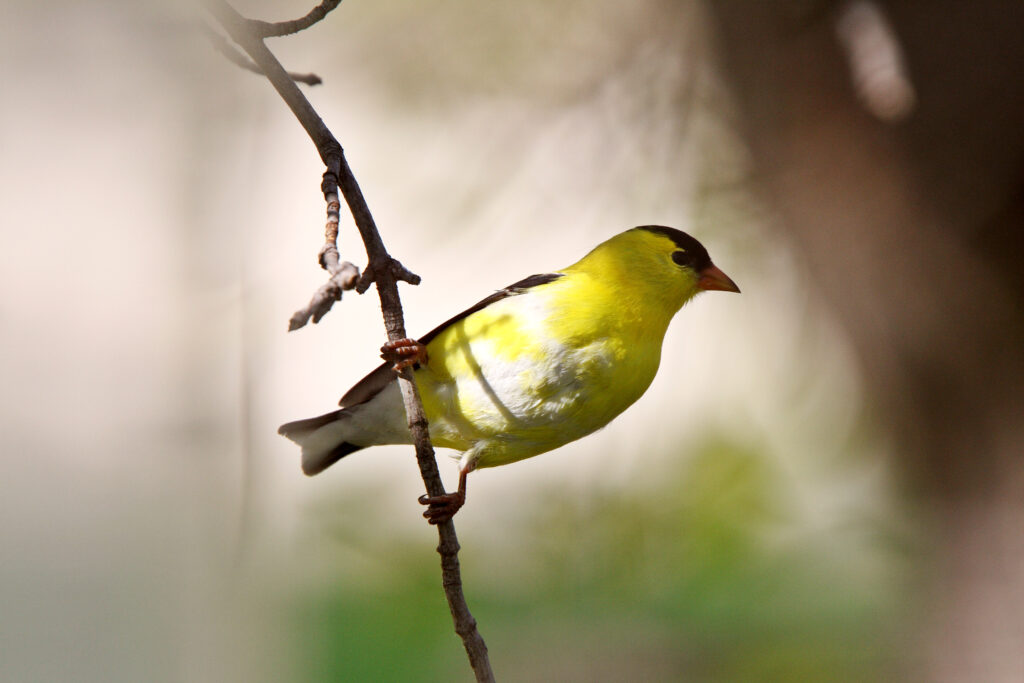
During the nesting season, American Goldfinches might well be found in southern Manitoba from May to September. Some, though, remain throughout the year. They are documented in approximately 25% of summer and 1% of cold weather checklists reported to the province by bird watchers.
American Goldfinches are famous birds during spring due to their striking yellow and black colors. Both males and females have a duller brown coloration throughout the winter.
Almost all of North America is home to American Goldfinches, which are normally present throughout the year. Those that breed across Canada and the Midwest, on the other hand, move south for the wintertime.
They may be seen searching for thistle, sunflower, and aster plants in weedy landscapes and overgrown places. They’re also abundant in parks and gardens.
Plant thistles and milkweed to entice American Goldfinches toward your garden. They will flock among most bird sites and enjoy sunflowers and nyjer seed.
| Scientific Name | Spinus tristis |
| Weight | 12 to 20 grams (0.3 to 0.7 ounces) |
| Length | 12 to 13 centimeters (4.2 to 5.1 inches) |
| Wingspan | 18 to 22 centimeters (7.4 to 8.7 inches) |
15. Yellow-rumped Warbler

Yellow-rumped Warblers are visible across Manitoba throughout the nesting season; however, their numbers rise throughout migrating from April to May and between September and October. They are documented in 21% of summertime and up to 42% of migratory checklists.
Yellow-rumped Warblers are typically grey with white wings and yellow streaks, particularly on the face, sides, and rump.
The color of winter birds is paler brown, having beautiful yellow rumps and shoulders that turn bright yellow and greyish in the spring. Females are slightly darker brown as compared to males.
Yellow-rumped Warblers are mostly found across Canada, as well as in areas of the Rockies and the Appalachian Mountains.
They may be observed in the Midwest throughout migration before overwintering across southern and southwestern US territories, the Pacific Coast, and Mexico and Central America.
Yellow-rumped Warblers can be spotted among pine woods during the mating season. They can also be found across open places having fruiting bushes in the winter. They consume insects largely and migrate during the summer, and are mostly fruit in the winter, particularly bayberry and wax myrtle.
| Scientific Name | Setophaga coronata |
| Weight | 11 to 13 grams (0.5 to 0.6 ounces) |
| Length | 11 to 14 centimeters (4.6 to 5.5 inches) |
| Wingspan | 18 to 23 centimeters (7.6 to 9.1 inches) |
16. Common Grackle

Despite being a near-threatened bird, Common Grackles are regularly observed in Manitoba throughout the summer, appearing on 21% of checklists. Although just a handful stays all year, they could be seen here through mid-April to the beginning of November during the breeding season.
The Common Grackle is indeed a blackbird with a glossy iridescent body that is larger and has longer tails than other blackbirds.
Common Grackles live in the southern states throughout the year, although those that nest across Canada and the Midwest travel south.
They gather in vast flocks up in the trees and eat a wide range of crops, especially maize. They will, however, devour rubbish and hence may be a problem. Their habitat consists of marshes, fields, parkland, and open forests.
During the winter season, millions of them could assemble to forage and perch with other blackbird species.
| Scientific Name | Quiscalus quiscula |
| Weight | 75 to 142 grams (2.5 to 5.0 ounces) |
| Length | 27 to 34 centimeters (11.1 to 13.4 inches) |
| Wingspan | 35 to 46 centimeters (14.1 to 18.1 inches) |
Conclusion
These are among the most common birds across Manitoba, and they may frequent the garden or feeders. They are the birds that seem to be the most often on bird’s state checklists.
The data is a compilation of the most often seen birds throughout Manitoba all across the summertime, winter, and the entire year.
FAQ
How many bird species are found across Manitoba?
Manitoba is home to approximately 145 bird species, with almost 88% of them migrating yearly.
What is Manitoba's provincial bird?
On July 16, 1987, Manitoba designated the great grey owl (Strix nebulosa) just like its state bird. With a wingspan of approximately 1.3 meters, the great grey owl is indeed the biggest owl in North America (4 feet). The owl may be observed all year throughout the province.
Last Updated on March 22, 2023 by Lily Aldrin
